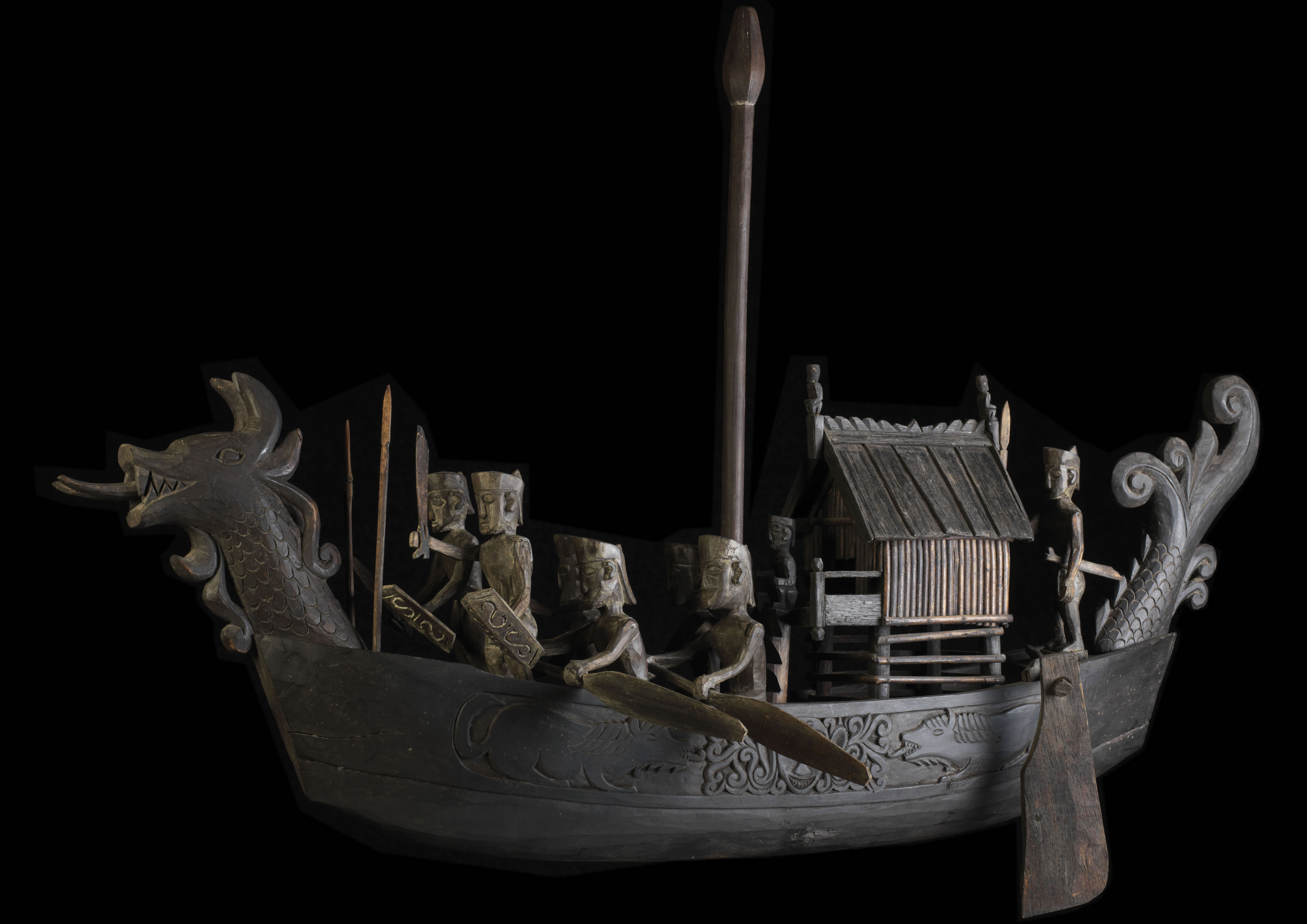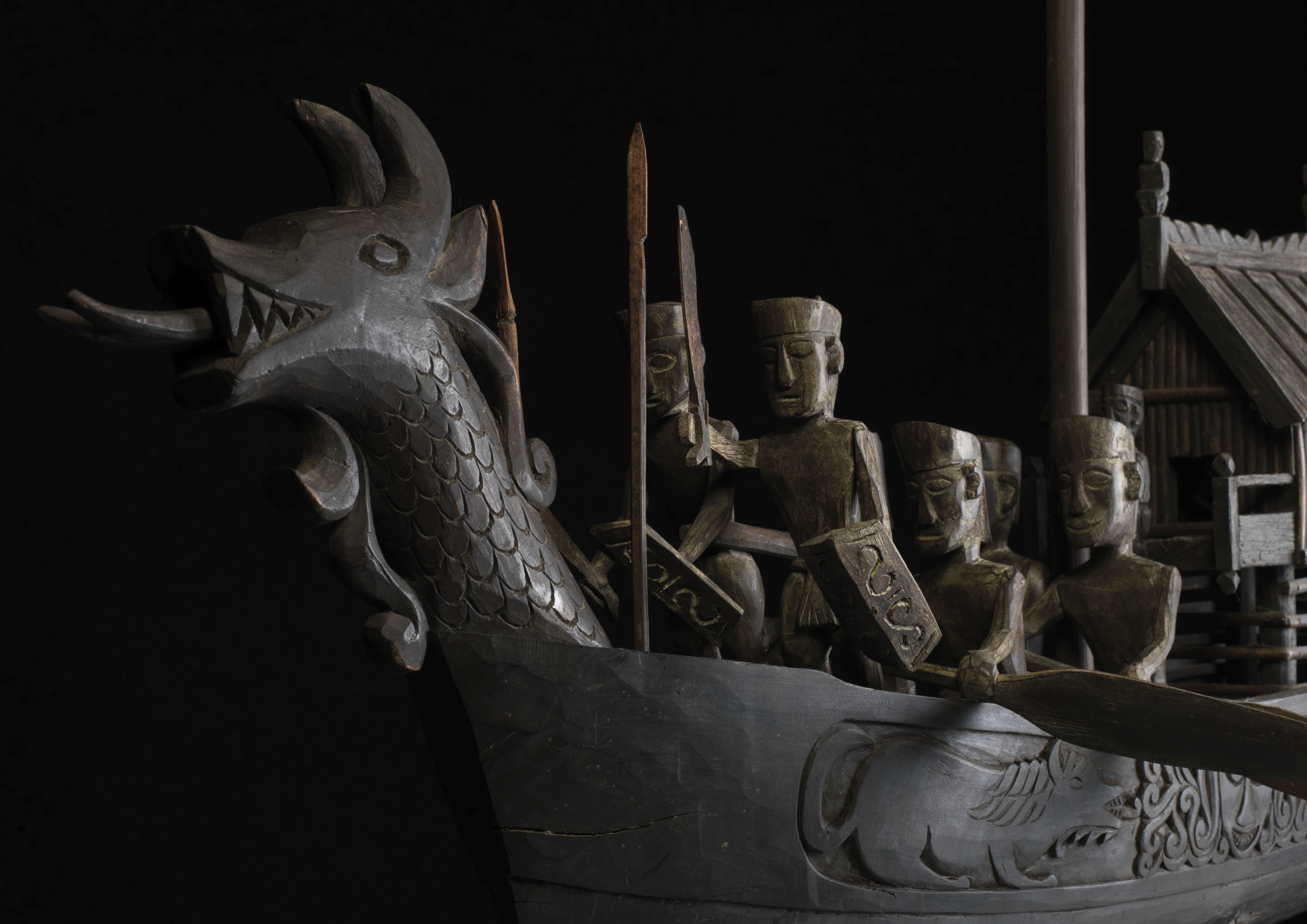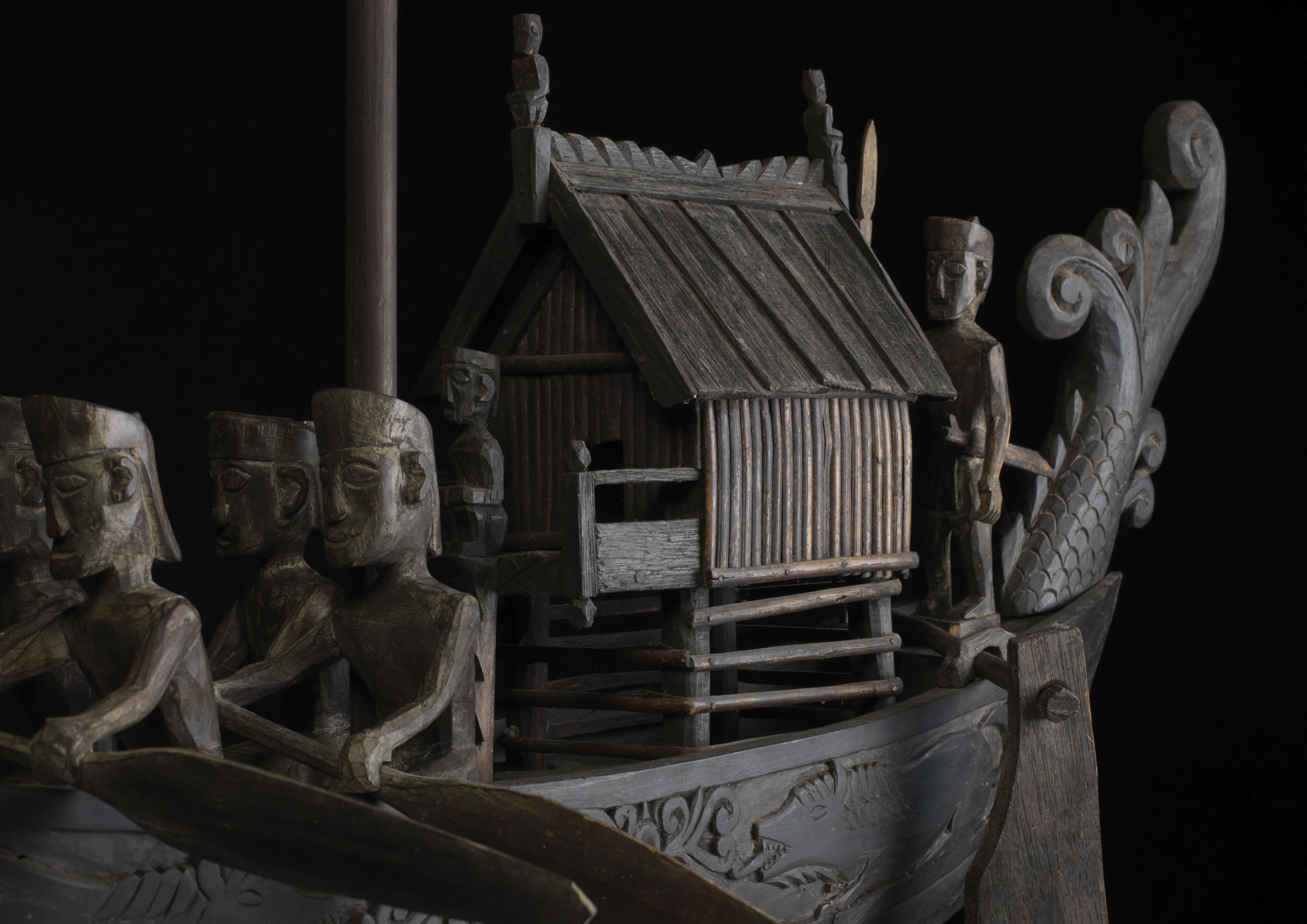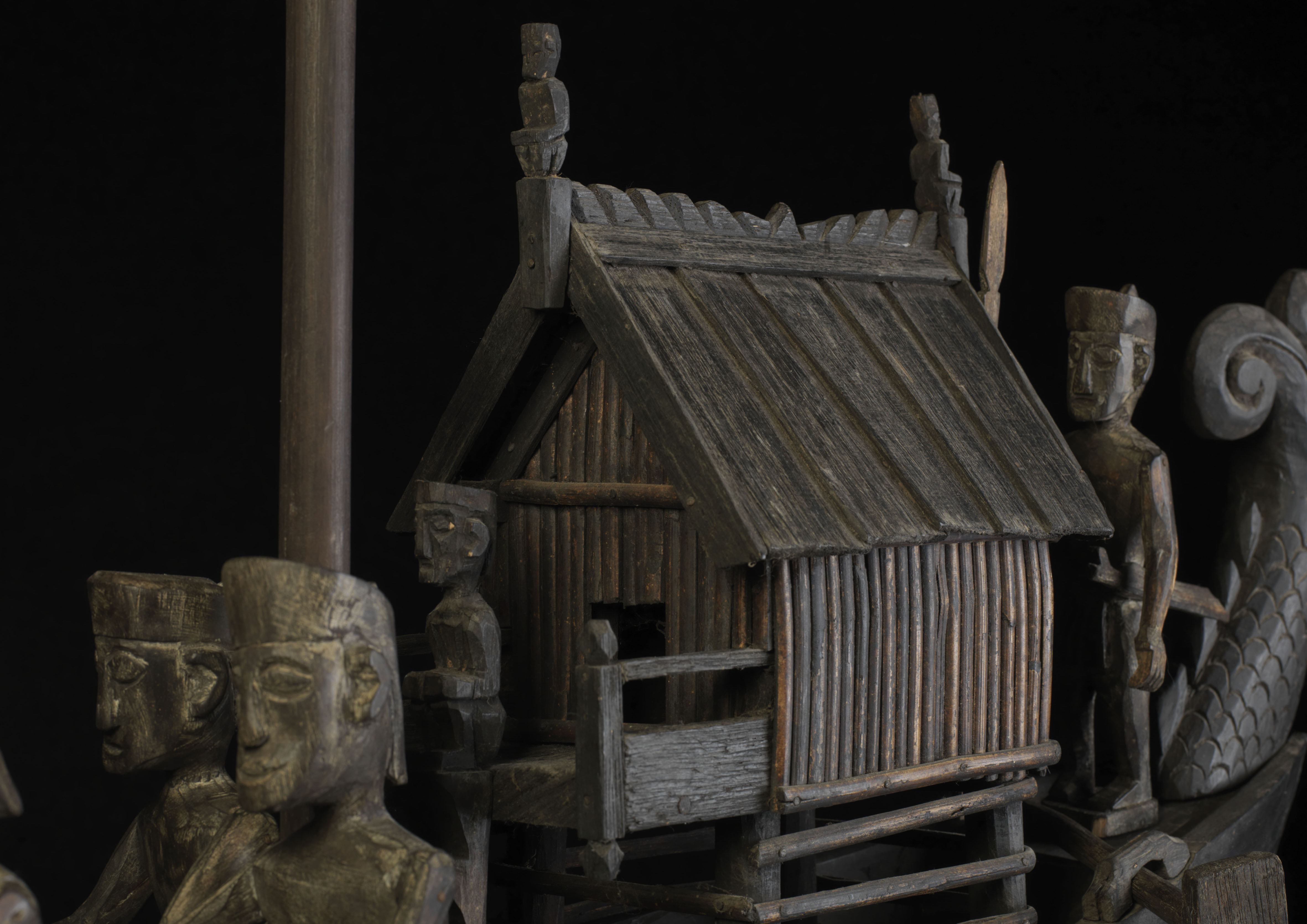Object: Soul ship
Culture and time: Borneo
The soul ship (telun) is an old concept of the Dayak on Borneo, which originally probably goes back to the Egyptian sun barque of Ra. It was believed that the souls rise from the under-world in the east and „go down“ in the west and enter the under-world, similar to the sun. The afterlife is therefore always in the west. It is assumed that the dead person travels on a river that starts wide at first and leads through a narrow gorge with a whirlpool of fire at the end, the entrance to the realm of the dead. In the cottage is the soul, the objects on the frame are precious pusaka, for example gongs, which were given to the dead person. They shine on the way to the hereafter, therefore they are important for the journey. The tattoos of the dead person, which stand for personal achievements, e.g. also those of the head-hunting, shine on the way as well. Before the ceremony of Tantolak (first burial) the dead person was dressed in the most precious clothes and surrounded with personal belongings. The dead without merits and possessions can therefore not find the way and cannot be reunited in their descendants. They wander around until they can „travel“ with a deserving nobleman in the context of a second burial. Meanwhile, the rice that was sprinkled on the corpse for the first burial is used by the rice soul Gana to provide food for the deceased in the afterlife. The second burial, the Tiwah (Feast of Redemption), usually takes place months or even years after the death of the person. While the deceased waits for his redemption in the hereafter, his soul resides in a wooden board on which a ship of the dead is painted and placed at the house of the deceased.
The long period between the two burials is due to the fact that the Tiwah festival is a very elaborate and expensive festival and can last up to a month. Therefore, nowadays often several deceased are celebrated together.
During the festival it was customary to carve Hampatong (small wooden sculptures), which are supposed to represent the slaves of the deceased.
It was also believed that blood would strengthen the sun or the boat on the way, possibly because it rises and sets red. That is why the path of the sun and the soul is usually depicted with blood sacrifices, including headhunting. Headhunting was essential for burials of nobles. This is probably also the meaning of the octagonal star, which is often found on the mandau (Surya Majapahit, the „Sun of Majapahit“).
The ships with a hornbill bow are called ba-nama tinggang („big/high name“) and always represent nobility, while the dragon bow (aso) represents the“standard model“.
//Objekt: Seelenschiff
Kultur und Zeitstellung: Borneo
Das Seelenschiff (telun) ist ein altes Konzept der Dayak auf Borneo, das ursprünglich wahrscheinlich auf die ägyptische Sonnenbarke von Ra zurückgeht. Man glaubte, dass die Seelen ähnlich wie die Sonne im Osten aus der Unterwelt aufsteigen und im Westen „untergehen“ und in die Unterwelt eingehen. Das Jenseits liegt demnach immer im Westen. Es wird vermutet, dass der Tote auf einem Fluss reist, welcher erst breit anfängt und am Ende durch eine enge Schlucht mit einem Feuerstrudel am Ende, dem Eingang in das Totenreich, führt. Im Häuschen ist die Seele, die Objekte an dem Gestell sind kostbare pusaka, beispielsweise Gongs, aufgehängt, die dem Toten mitgegeben wurden. Sie leuchten auf dem Weg ins Jenseits, darum sind sie für die Fahrt wichtig. Auch die Tätowierungen des Toten, die für persönliche Leistungen, z.B. auch die der Kopfjagd stehen, leuchten ebenfalls auf dem Weg. Der Tote wurde vor der Zeremonie des Tantolak (Erstbestattung) in seiner kostbarsten Kleidung gekleidet und mit seinen persönlichen Besitztümern umringt. Die Toten ohne Verdienste und Besitz können daher den Weg nicht finden und auch nicht in ihren Nachkommen wiedervereinigtwerden. Sie irren solange herum, bis sie mit einem verdienstvollen Adligen im Rahmen der Zweitbestattung „mitreisen“ können. Währenddessen dient der Reis, welcher für die Erstbestattung auf die Leiche gestreut wurde, dafür, dass die Reisseele Gana den Verstorbenen im Jenseits mit Nahrung versorgt. Die Zweitbestattung, das Tiwah-Fest (Fest der Erlösung), findet meistens Monate oder auch Jahre nach dem Tod des Menschen statt. Während der Tote im Jenseits auf seine Erlösung wartet, hält sich seine Seele in einem Holzbrett auf, auf welches ein Totenschiff gemalt ist und sich am Haus des Verstorbenen befindet.
Der lange Zeitraum zwischen den beiden Bestattungen ist darauf zurückzuführen, dass das Tiwah-Fest ein sehr aufwändiges und teures Fest ist und bis zu einem Monat dauern kann. Heutzutage werden deshalb oft mehrere Verstorbene zusammen gefeiert werden.
Während des Fests war es üblich, Hampatong (kleine hölzerne Skulpturen) zu schnitzen, welche die Sklaven des Verstorbenen darstellen sollen.
Man glaubte auch, Blut würde die Sonne bzw. das Boot auf dem Weg stärken, möglicherweise weil sie rot auf- und untergeht. Darum wird der Sonnen- und Seelenweg meist mit Blutopfern dargestellt, dazu gehört auch die Kopfjagd. Für Bestattung von Adligen war Kopfjagd unerlässlich. Das ist vermutlich auch die Bedeutung des achteckigen Sterns, den man an den mandau öfter findet. (surya Majapahit, die „Sonne von Majapahit“)
Die Schiffe mit einem Nashornvogel-Bug heißen ba-nama tinggang („großer/hoher Name“) und stehen immer für Adlige, während der Drachenbug (aso) das “Standardmodel“ darstellt.







Hinterlasse einen Kommentar